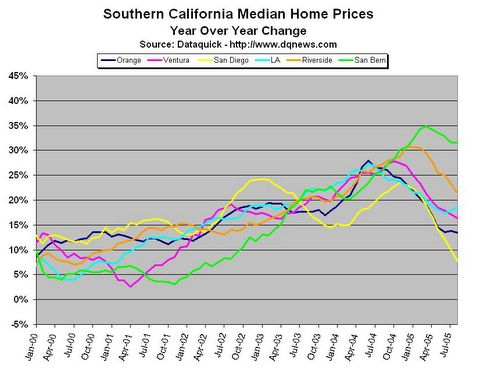Me and My Blog
Saturday, September 17, 2005
This bit of information is being provided for first time readers who may be curious or confused about what it is they are reading here in this little corner of the blogosphere.
Who am I?
I am a retired software engineer in my mid-forties, living in Southern California. This blog is a vain attempt to stave off a mid-life crisis, and I'm really hoping that it's going to work. Every time I pass by one of those BMW or Porsche dealerships, I think to myself - just go home and write something, you'll thank yourself in the morning...
No, that's not really why I write this. The real reason that I write this blog is that a few years ago, I developed a healthy curiosity about personal finance, financial markets, macroeconomics, and economic history after witnessing the rise and fall of my retirement and investment accounts during the stock market bubble and bust.
This is where it has led.
Long ago, I was accepted to college as an engineering major, then I switched to business, then I took a microeconomics class, and then I quit school. The microeconomics class had little to do with me leaving, but upon returning to school, I changed my major back to engineering. I finished school and went to work as an engineer, devoid of any thoughts related to micro or macroeconomics for the better part of twenty years.
The bursting of the Nasdaq bubble got my attention. I began to read all that I could via the internet - mainstream financial news, government websites, and many alternative sources of financial news. I quickly determined that the alternative sources of financial news made a lot of sense to my engineering mind, unencumbered as it was, with mainstream contemporary economic thought.
Major influences have been Financial Sense Online, The Daily Reckoning, Prudent Bear, The Ludwig Von Mises Institute, and many others - see the links to the right.
What am I doing?
The purpose of this blog is to help shed light on the underbelly of today's economy and to have a few laughs along the way. It seems that the entire world is being led along by government officials, central bankers, economists, and the mainstream financial media, most of whom seem to have some sort of vested interest in not providing a complete picture of our economy and our financial markets.
There are a growing number of individuals, like myself, who are trying to tell the world that the GDP, CPI, and employment statistics are not what they appear to be - that there is an inherent bias (to put it nicely) in the reporting of our economic condition, and that maybe things are not as others would like for you to believe.
It seems most people have not the time, the ability, and the inclination to look past the headline economic statistics, the current issue of their favorite personal finance magazine, or the current market value of their home - they don't smell anything funny.
Along with a growing number of other writers, I believe that our economy does smell funny. In fact "smell" isn't really the right word - it's more like a "stench".
Primarily, this stench has to do with massive amounts of debt everywhere, out-of-control government finances, the poor quality of job creation in recent years, and most importantly, a stock market bubble that morphed into a housing bubble.
Most people do not yet smell the stench - some are just now starting to get a whiff of it.
What's up with the name?
One of the first things you have to do when you create a blog is to give it a name. Then you have to announce yourself to the rest of the world with your first post - something like, "This is my first post". Many people stop there.
What I really wanted for the name of this blog was something like "Our Economy", because I wanted to be able to write about anything having to do with the economy or financial markets. But how dull would a name like that be?
Then I thought, "Well, what word best describes our economy?"
To me, clearly, today's economy is a mess. Most people don't realize it yet, but they are beginning to understand that all is not well. Soon, more people will be referring to this economy as a mess.
The next question is, "Who made this mess?"
While Federal Reserve Chairman Alan Greenspan is not solely responsible for the condition in which we find ourselves, he, more than any other individual, should get the credit or blame for what happens in the world economy in the next few years.
I, like many others today, believe the coming years will not be pretty - that we will all be living with the mess that Greenspan made for years to come.
I may be wrong. We'll see.








